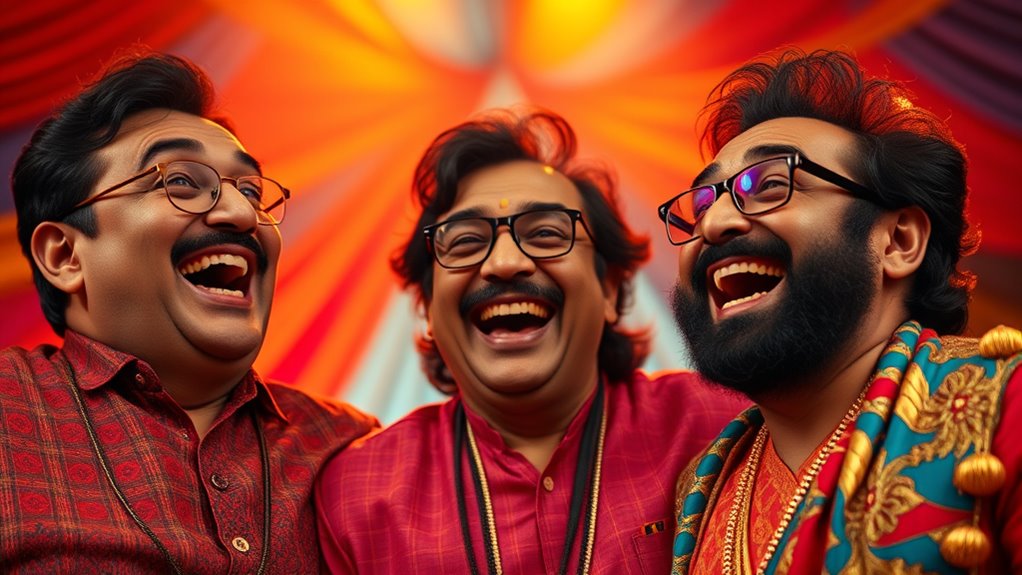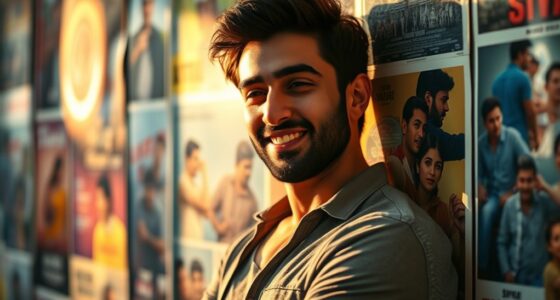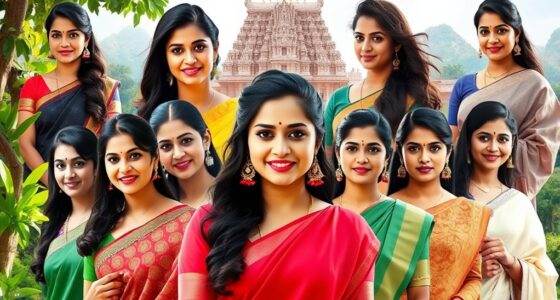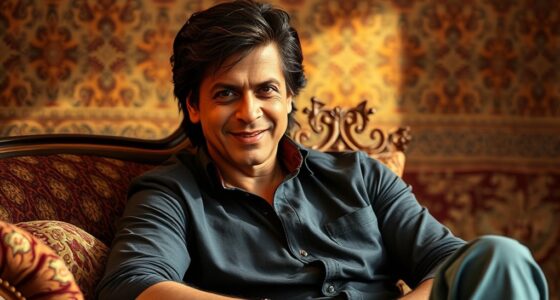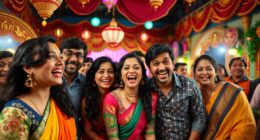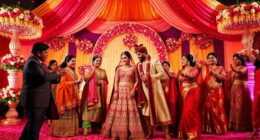Bollywood’s comedy kings include legends like Johnny Walker, Mehmood, Jagdeep, Keshto Mukherjee, and Johnny Lever, each famous for hilarious roles that have become iconic. Their unique styles, from slapstick to witty dialogue, helped shape Indian humor and cultural identity. As comedy evolved through the 80s, 90s, and today’s digital era, these actors set the foundation for modern talents like Kapil Sharma and Zakir Khan. Continue exploring to uncover the full story of Bollywood’s funniest legends.
Key Takeaways
- Legendary comedians like Johnny Walker, Mehmood, Jagdeep, Keshto Mukherjee, and Paintal shaped Bollywood comedy with iconic roles.
- Johnny Walker’s drunk comic persona in films like *Mother India* set early standards for humor.
- Mehmood’s unforgettable roles in *Padosan* and *Bombay to Goa* established him as Bollywood’s first superstar comedian.
- Jagdeep’s memorable portrayal of Soorma Bhopali in *Sholay* remains a classic comedic performance.
- Modern comedians like Kapil Sharma and Zakir Khan continue the legacy with stand-up and digital comedy.
Pioneers of Bollywood Comedy: The Early Legends
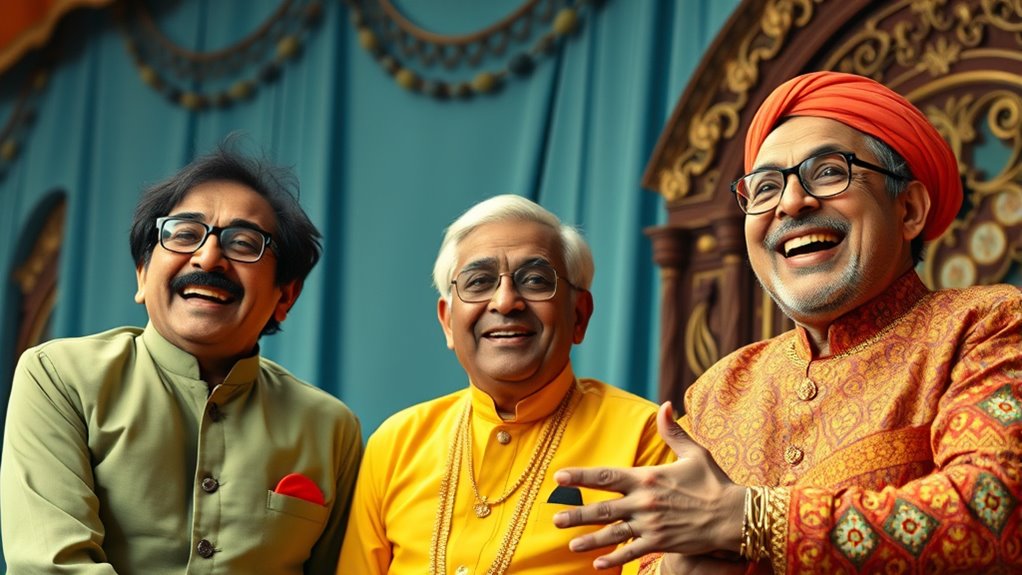
The pioneers of Bollywood comedy laid the foundation for the genre’s rich history, bringing humor to Indian cinema through unforgettable characters and unique styles. Johnny Walker, famous for his drunk shenanigans, became one of India’s earliest beloved comedians, while Mehmood broke new ground as the first superstar comedian in Hindi films, shining in *Sasural (1961)*. Jagdeep acted in over 400 films, mainly in comic roles, and Keshto Mukherjee, though sometimes overshadowed, added his charm to early comedies. Paintal, a FTII graduate, initially played comic roles before exploring other genres. These actors created memorable characters—Mehmood in *Padosan*, Johnny Walker in *Mother India*, Jagdeep as Soorma Bhopali, and Keshto in *Parichay*. Their pioneering work established the comedic landscape that would influence Bollywood for decades. Johnny Walker’s unique style of improvisation and timing inspired many comedians who followed, shaping the evolution of Bollywood comedy. Additionally, the integration of media and entertainment technologies like AI has begun to influence how comedy content is created and consumed today.
A deeper understanding of their cultural impact reveals how these comedians influenced Indian popular culture and comedy styles worldwide. Furthermore, their innovative use of comedic techniques set new standards for humor in Indian cinema, inspiring future generations of comedians.
The 80s and 90s: Shaping Modern Humor
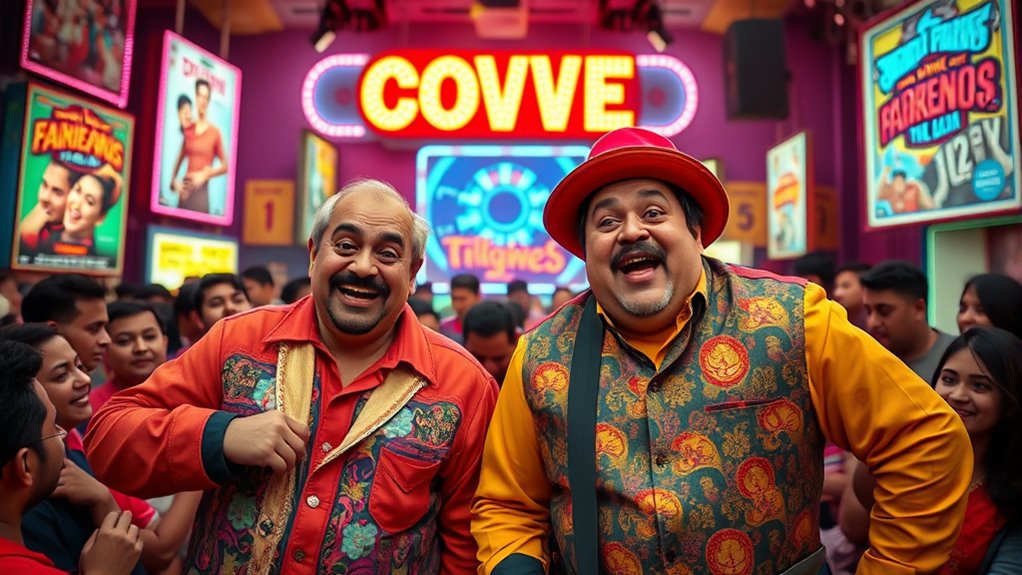
Have you ever wondered how Bollywood comedy evolved during the 80s and 90s? During this period, the focus shifted from dedicated comedians to hero-driven humor. As heroes took on their own comedic roles, traditional comedians like Asrani transitioned into supporting parts, and comedy became integrated into action films. Audience tastes evolved, favoring stars who combined action, romance, and humor. This shift contributed to a genre-blurring of Bollywood films, where comedy lightened dramatic plots. Slapstick and situational comedy gained popularity, with films like *Raja Babu* and *Coolie No. 1* emphasizing physical humor and witty dialogue. Social satire also grew, with films parodying societal norms and politics. The era’s comedy reflected social changes, urban aspirations, and the influence of television, shaping modern Bollywood humor into a more glamorous, multi-layered genre. Additionally, comedy in Bollywood began incorporating more contemporary themes, making humor more relatable and reflective of evolving societal values. The integration of comedic elements into action films contributed significantly to this transformation, further broadening the scope of Bollywood humor. Moreover, the rise of stand-up comedy as a popular form also influenced mainstream Bollywood humor, bringing a new edge and authenticity to comedic storytelling. This period laid the foundation for the diverse comedic styles that are prevalent in Bollywood today.
Contemporary Comedic Talents and Their Iconic Roles
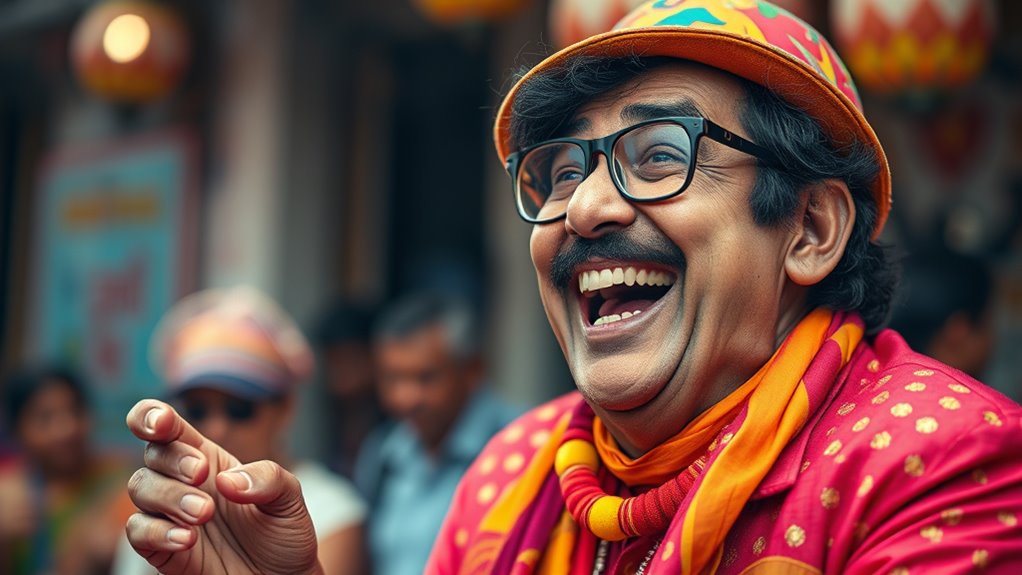
Contemporary Bollywood comedy is driven by a new generation of talented actors who blend traditional humor with modern sensibilities. You see this in stars like Kapil Sharma, whose TV shows and live performances attract millions, and Bhuvan Bam, who gained fame through viral YouTube sketches. Ashish Chanchlani’s digital videos also command a large following, showcasing the power of online platforms. Meanwhile, veterans like Johnny Lever continue to influence new comedians, bridging classic and modern humor. Stand-up comedians like Zakir Khan and Anubhav Singh Bassi craft relatable stories and rustic humor that resonate with today’s audiences. These talents leverage social media and streaming platforms, expanding their reach and redefining Indian comedy’s landscape with fresh, diverse styles. Johnny Walker’s pioneering work laid the foundation for the comedic talents of today, inspiring many performers to experiment with humor that combines wit, improvisation, and cultural references.
The Evolution of Humor: From Slapstick to Satire

Bollywood’s comedy style has evolved considerably over the decades, shifting from simple slapstick routines to more sophisticated forms like satire and social commentary. In the early days, slapstick humor dominated, with physical gags and exaggerated antics, especially during the black-and-white era. As films progressed, situational comedy became popular, exemplified by classics like *Padosan* and *Chupke Chupke*, which relied on clever setups and dialogues. Mistaken identities and cross-dressing plots added layers of humor during the 1970s and 1980s. Recently, comedy has embraced satire, addressing societal issues with wit, and incorporating wordplay and cultural references. This evolution reflects Bollywood’s ability to adapt humor styles, making films more relatable and engaging while continuously expanding its comedic scope. The inclusion of satire and social commentary has marked a significant shift in how comedy is presented, with filmmakers increasingly aiming for humor that also provokes thought and discussion. Furthermore, the integration of cultural references enhances the humor’s relevance and impact, resonating deeply with diverse audiences. Additionally, advancements in sound recording techniques and equipment have allowed filmmakers to craft more nuanced comedic soundscapes, enriching the overall humor experience. The development of visual effects and digital editing has also played a crucial role in creating innovative comedic visuals, enabling more creative storytelling. As technology progresses, the use of special effects and visual comedy has further broadened the scope of visual humor in Bollywood films. Incorporating digital editing techniques has also enabled more creative and seamless comedic moments, captivating audiences with innovative visual humor.
Comedians’ Impact on Indian Cultural and Entertainment Landscape
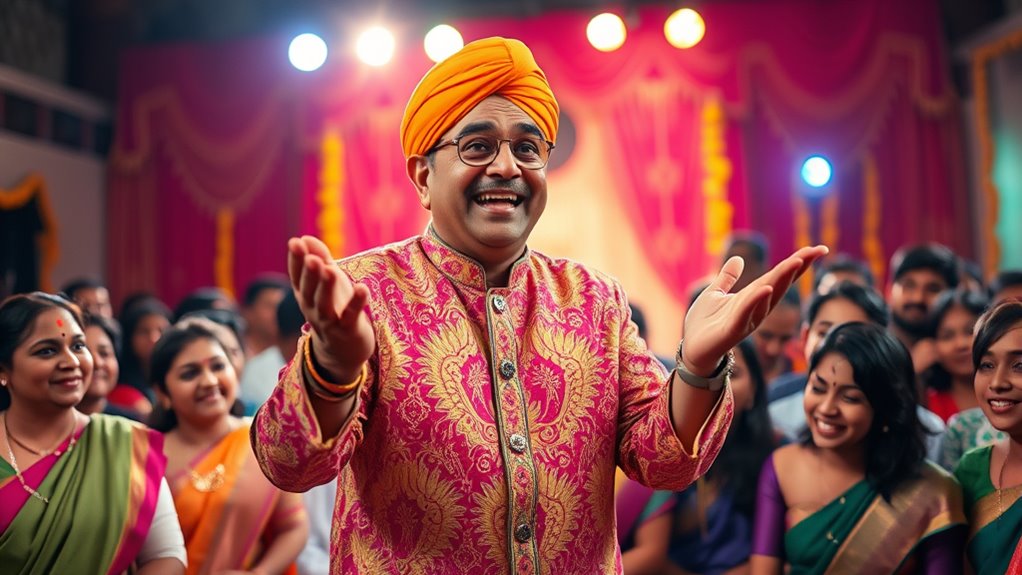
Comedians have profoundly shaped Indian culture and entertainment by bringing humor into everyday life and cinematic storytelling. Icons like Johnny Lever, Paresh Rawal, and Rajpal Yadav have transformed Bollywood comedy, influencing generations of performers. You’ll notice how diverse genres—slapstick, satire, parody—resonate with audiences, reflecting cultural nuances and making comedy relatable. Films like Golmaal have broken box office records, showcasing comedy’s financial power and global appeal. Comedians such as Vir Das and Kapil Sharma have successfully moved from stand-up to film, expanding their influence. Their humor often blends social commentary, engaging audiences and shaping public opinion. Comedy’s universal appeal fosters a vibrant entertainment landscape, creating opportunities and elevating comedy as a crucial cultural force in India today. Additionally, the unique cultural nuances embedded in Indian humor have helped comedy become an integral part of national identity and cultural expression. Furthermore, the diversity of comedic styles across different regions enriches the overall entertainment scene, highlighting the eclectic nature of Indian humor. Recognizing the importance of live performances in comedy, many comedians continue to perform in front of audiences, preserving traditional humor forms while innovating new styles. The infusion of social and cultural issues into comedy also allows performers to connect deeply with audiences and comment on contemporary society. In addition, understanding the history of Indian comedy reveals how humor has evolved alongside social changes and technological advancements, shaping the comedic landscape today.
Frequently Asked Questions
How Did Bollywood Comedy Evolve From Silent Films to Talkies?
You’re curious about how Bollywood comedy transformed from silent films to talkies. As sound was introduced, films gained dialogue, music, and sound effects, making comedy more expressive and relatable. This shift allowed for more complex jokes, character development, and social commentary. You’d notice that comedians and actors started experimenting with timing and dialogue, leading to a richer, more engaging comedic style that set the foundation for Bollywood’s vibrant comedy genre today.
What Influences Shaped the Comedic Styles of Early Bollywood Comedians?
Think of Bollywood comedy styles as a vibrant tapestry woven from many influences. You’d see slapstick rooted in folk traditions, like a colorful street performance. British wit added sharpness, while Indian mythology brought exaggeration. Theatre backgrounds shaped expressive gestures, and Western performers inspired energetic acting. Writers crafted character-driven humor, blending genres. All these elements combined, creating a rich, diverse comedic style that appeals universally and reflects India’s cultural mosaic.
How Has Societal Change Impacted the Portrayal of Humor in Bollywood?
You see, societal changes have considerably shaped humor in Bollywood. As society evolves, you notice filmmakers and comedians tailoring content to reflect current issues, cultural sensitivities, and global influences. You’ll find humor now more nuanced, often blending satire, social commentary, and entertainment. This shift allows audiences to connect deeper with the jokes, making comedy more relevant, diverse, and responsible, adapting to the changing social landscape.
Which Contemporary Comedians Are Considered the Torchbearers of Legacy?
You see, today’s talented trailblazers like Kapil Sharma, Aashish Solanki, and Aakash Gupta take the torch and turn tradition into trend. They blend bold humor with cultural insight, enthralling crowds on screens and stages. Digital dynamos like CarryMinati and Ashish Chanchlani connect with countless fans online. These comedians carry the legacy of laughter forward, blending classic comedy with contemporary charm to shape India’s vibrant comedy landscape.
How Do Modern Bollywood Comedies Address Social Issues Differently?
You see, modern Bollywood comedies tackle social issues differently by blending humor with sharp social commentary. They incorporate contemporary themes like gender identity and class disparities, using satire to critique societal norms. These films often reflect cultural complexities and encourage dialogue, making sensitive topics more approachable. Streaming platforms help spread these messages globally, engaging viewers and fostering awareness. Overall, they use comedy as a powerful tool for social reflection and change.
Conclusion
Just like Charlie Chaplin once charmed audiences worldwide, Bollywood’s comedians continue to shape laughter across generations. Their iconic roles echo through time, turning everyday moments into comedy gold. As you’ve seen, their evolution from slapstick to satire mirrors India’s own cultural journey. So next time you laugh at a classic scene, remember—you’re part of a grand legacy, where humor unites us all, much like the timeless stories of the world’s greatest entertainers.
